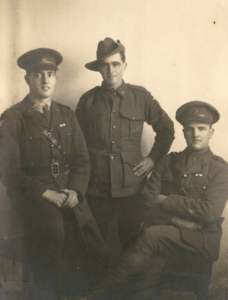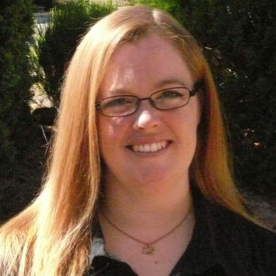One Among Many
By Dr Meleah Hampton at the Australian War Memorial
We hear lots of amazing stories from our community at Boronia Travel, and this month we share a touching story by one of our battlefield guides and Australian War Memorial historian, Dr Meleah Hampton. Meleah will be co-leading an exclusive ladies only tour to the Western Front this July, and will explore the main sites Australian’s saw action during the World War One campaign of 1914 -1918.Here is Meleah’s story…
 Jack Stewart Sydney McCann (pictured centre) was born in Adelaide on the 6th of December 1895. He was educated in Adelaide and Peterborough, and became a clerk. He enlisted in the Australian Imperial Force shortly after his 21st birthday, following in the footsteps of his older brothers, Bill and Cyril. Both of his brothers would go on to serve with great distinction as commissioned officers. Cyril was awarded the Military Cross for his work at Westhoek Ridge in 1917. Bill, one of only a handful of men to leave Australia as a sergeant and return as a lieutenant-colonel, was mentioned in dispatches, and awarded a Military Cross and bar and the Distinguished Service Order during his five years abroad.
In contrast, Jack McCann was just a lance-corporal when he was killed at Hamel in July 1918. He was buried not far from where he fell, and his company commander wrote to his parents to say, “it is with very great regret that I have to inform you of the death of your son… His unfailing cheerfulness was remarkable, and did much to lighten the monotony of life in trenches and billets for those who came in close touch with him. I cannot speak too highly of his soldierly qualities.” Just weeks after Jack died, Bill McCann was with the 10th Battalion advancing through to the front. Exhausted after a long march, he and his men dropped to sleep where they stopped. Bill McCann woke the next morning to find that he had been sleeping on Jack’s grave, not even knowing he had been killed.
After the war, when northern France was being put back in order and the Imperial War Graves Commission was establishing cemeteries across the region, Jack McCann’s remains were exhumed and reinterred in Crucifix Corner Cemetery, near Villers-Bretonneux. And that was where I found him in 2001, on my first battlefield tour. Deeply moved by the graves of so many young Australians so far from home, I was particularly touched by the epitaph chosen by Jack’s parents in Adelaide: “In loving memory of our dear boy Jack. Well done.” Those words—well done—made me cry, standing in a cemetery between a sugarbeet field and building works for the new Villers-Bretonneux exit on the A29. I will forever be grateful to them for that emotional release.
Jack McCann became my new project. I researched his life, and everything I found out about him and his brothers made the “well done” even more evocative of a lovely, caring family. I visited Jack’s grave every time I was in France, and used him as a research tool for every new archive, just in case I had missed something. Twelve years after that spring day in Crucifix Corner Cemetery, I became a military historian at the Australian War Memorial, and, learning about the collection database in more detail I discovered a packet of partially catalogued photographs. In that packet was the one thing I had never been able to find—a photograph of Jack, Bill and Cyril.
All of my great grandfathers who served in the Great War returned to Australia. And yet, my journey to the battlefields became deeply personal through a connection to a single grave. Jack McCann, a completely unknown young man, has had his story shared at the War Memorial’s Last Post Ceremony, in our virtual reality experience, in our magazine Wartime, and in many interviews I have conducted since becoming a professional historian. Jack McCann has become such a part of my life that my eldest son is named Jack in his honour.
Visiting the battlefields of northern France and Belgium is an amazing experience. It speaks of enormous, sweeping battles, huge human endeavours and insignificant individuals all at once. And of course, every individual becomes significant on closer inspection. I found my story on the battlefields – what is yours?
Jack Stewart Sydney McCann (pictured centre) was born in Adelaide on the 6th of December 1895. He was educated in Adelaide and Peterborough, and became a clerk. He enlisted in the Australian Imperial Force shortly after his 21st birthday, following in the footsteps of his older brothers, Bill and Cyril. Both of his brothers would go on to serve with great distinction as commissioned officers. Cyril was awarded the Military Cross for his work at Westhoek Ridge in 1917. Bill, one of only a handful of men to leave Australia as a sergeant and return as a lieutenant-colonel, was mentioned in dispatches, and awarded a Military Cross and bar and the Distinguished Service Order during his five years abroad.
In contrast, Jack McCann was just a lance-corporal when he was killed at Hamel in July 1918. He was buried not far from where he fell, and his company commander wrote to his parents to say, “it is with very great regret that I have to inform you of the death of your son… His unfailing cheerfulness was remarkable, and did much to lighten the monotony of life in trenches and billets for those who came in close touch with him. I cannot speak too highly of his soldierly qualities.” Just weeks after Jack died, Bill McCann was with the 10th Battalion advancing through to the front. Exhausted after a long march, he and his men dropped to sleep where they stopped. Bill McCann woke the next morning to find that he had been sleeping on Jack’s grave, not even knowing he had been killed.
After the war, when northern France was being put back in order and the Imperial War Graves Commission was establishing cemeteries across the region, Jack McCann’s remains were exhumed and reinterred in Crucifix Corner Cemetery, near Villers-Bretonneux. And that was where I found him in 2001, on my first battlefield tour. Deeply moved by the graves of so many young Australians so far from home, I was particularly touched by the epitaph chosen by Jack’s parents in Adelaide: “In loving memory of our dear boy Jack. Well done.” Those words—well done—made me cry, standing in a cemetery between a sugarbeet field and building works for the new Villers-Bretonneux exit on the A29. I will forever be grateful to them for that emotional release.
Jack McCann became my new project. I researched his life, and everything I found out about him and his brothers made the “well done” even more evocative of a lovely, caring family. I visited Jack’s grave every time I was in France, and used him as a research tool for every new archive, just in case I had missed something. Twelve years after that spring day in Crucifix Corner Cemetery, I became a military historian at the Australian War Memorial, and, learning about the collection database in more detail I discovered a packet of partially catalogued photographs. In that packet was the one thing I had never been able to find—a photograph of Jack, Bill and Cyril.
All of my great grandfathers who served in the Great War returned to Australia. And yet, my journey to the battlefields became deeply personal through a connection to a single grave. Jack McCann, a completely unknown young man, has had his story shared at the War Memorial’s Last Post Ceremony, in our virtual reality experience, in our magazine Wartime, and in many interviews I have conducted since becoming a professional historian. Jack McCann has become such a part of my life that my eldest son is named Jack in his honour.
Visiting the battlefields of northern France and Belgium is an amazing experience. It speaks of enormous, sweeping battles, huge human endeavours and insignificant individuals all at once. And of course, every individual becomes significant on closer inspection. I found my story on the battlefields – what is yours?
About Your Tour Guide
 Dr Meleah Hampton is an historian at the Australian War Memorial. She has written extensively on the First World War from Gallipoli to Montbrehain, and is the author of two books on the Pozières campaign: Attack on the Somme: 1st Anzac Corps and the Battle of Pozières Ridge 1916 (Helion, 2016) and The Battle of Pozières: 1916 for the Army History Unit Campaign Series in 2018. Her primary interest lies in the operational conduct of the First World War, but she has also worked extensively in the field of military biography. A frequent visitor to the battlefields, Meleah is an engaging and knowledgeable speaker and student of the First World War. Meleah will be co-leading our exclusive ladies only tour of the Western front battlefields in July 2020.
Dr Meleah Hampton is an historian at the Australian War Memorial. She has written extensively on the First World War from Gallipoli to Montbrehain, and is the author of two books on the Pozières campaign: Attack on the Somme: 1st Anzac Corps and the Battle of Pozières Ridge 1916 (Helion, 2016) and The Battle of Pozières: 1916 for the Army History Unit Campaign Series in 2018. Her primary interest lies in the operational conduct of the First World War, but she has also worked extensively in the field of military biography. A frequent visitor to the battlefields, Meleah is an engaging and knowledgeable speaker and student of the First World War. Meleah will be co-leading our exclusive ladies only tour of the Western front battlefields in July 2020.
This entry was posted in Battlefield Tour Highlights, Historical Highlights. Bookmark the permalink.






